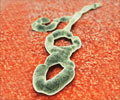
The treatment uses a sequence specific short strand of RNA, known as siRNA, designed to target and interfere with the Ebola virus, rendering it harmless. One of the advantages of this approach is the ability to quickly modify it to different viral strains.
Researcher Thomas Geisbert said that they quickly adapted their candidate treatment to target the Makona outbreak strain of Ebola virus and they were able to protect all of their nonhuman primates against a lethal Makona Ebola infection when treatment began three days following infection. At this point, those infected showed clinical signs of disease and had detectable levels of virus in their blood.
Although all infected animals showed evidence of advanced disease, those receiving treatment had milder symptoms and recovered fully. The untreated controls succumbed to the disease on days eight and nine, which is similar to that reported in the field after patients begin showing symptoms of Ebola.
This treatment also protected against liver and kidney dysfunction and blood disorders that occur during an Ebola infection. These results indicate that the treatment may confer protective benefits that go beyond improving survival rates and effective control of virus levels in the body.
The Tekmira siRNA-based therapeutic is now being evaluated in Ebola-infected patients in Sierra Leone.
Advertisement
Source-Medindia










